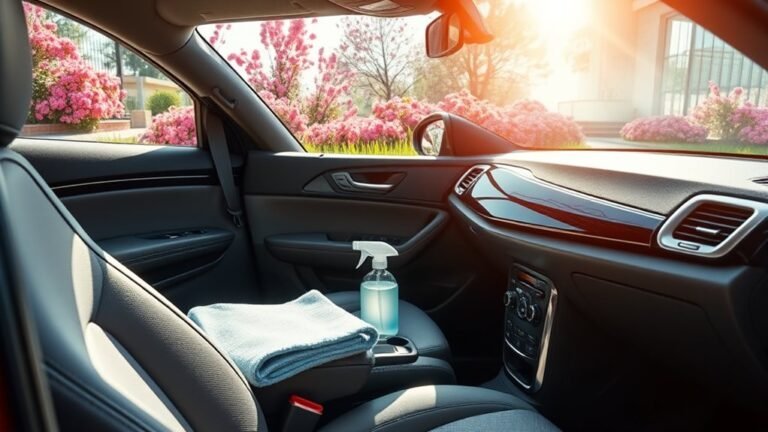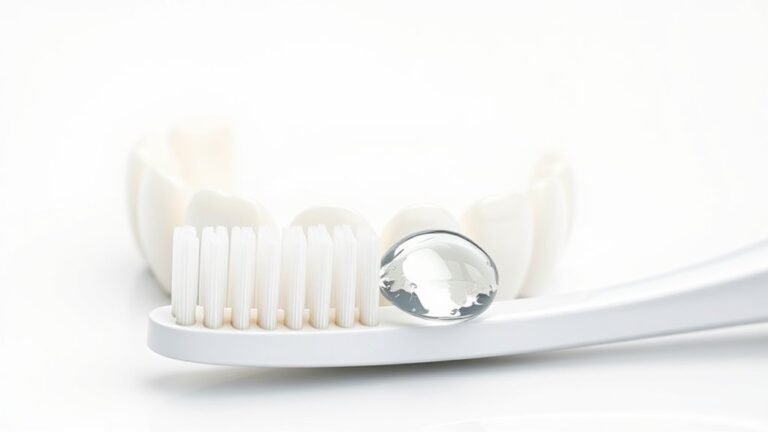Pre-Holiday Cleaning Checklist for Bike
Before your holiday rides, inspect your bike frame for cracks or misalignments and check components like brake pads and cables. Clean the drivetrain and chain using a degreaser, then apply fresh lubricant. Adjust your brakes to guarantee quick response and even pad contact. Inflate tires to the correct pressure and verify wheel alignment. Finish with a safety check of bolts, lights, and gears, followed by a short test ride to confirm everything’s smooth and ready. Keep going to uncover tips for prolonging your bike’s performance on the road.
Inspecting the Bike Frame and Components

Before you immerse yourself in cleaning, take a close look at your bike frame and components. You want to make sure the frame alignment hasn’t shifted from your last adventure—any misalignment can affect your ride’s smoothness and safety. Check for cracks, dents, or bends that could signal trouble ahead. Next, inspect component wear carefully; worn brake pads, loose bolts, or frayed cables can limit your freedom on the road or trail. Spotting these issues early means you’re less likely to face unexpected breakdowns. A thorough inspection not only extends your bike’s life but gives you confidence to ride freely, knowing your bike is ready for whatever journey you choose next. Take your time here—it’s the foundation of a great ride.
Cleaning the Drivetrain and Chain
Since the drivetrain and chain are the heart of your bike’s movement, keeping them clean is essential for smooth shifting and efficient pedaling. Proper chain maintenance and drivetrain cleaning free your ride from grime that can hold you back. When you take care of these parts, you release the true potential of your bike’s freedom.
Here’s how to keep your drivetrain and chain in top shape:
- Use a degreaser to break down stubborn dirt and old lubricant.
- Gently scrub the chainrings, cassette, and chain with a brush.
- Rinse carefully, avoiding high-pressure water that can force dirt into bearings.
- Dry completely and apply fresh lubricant to guarantee smooth, silent rides.
Embrace this care routine to enjoy every pedal stroke unburdened by wear or noise.
Checking and Adjusting the Brakes

Now’s a good time to inspect your brake pads for wear and make certain they’re still effective. If you notice they’re getting thin, it’s time to replace them. Also, check the brake cable tension to guarantee your brakes respond quickly and safely when you need them.
Inspect Brake Pad Wear
Brake performance relies heavily on the condition of your brake pads, so it’s crucial to inspect them regularly. Different brake pad types wear down at varying rates, impacting how well you can stop and control your ride. Before you hit the road, check for uneven wear, cracks, or thinning pads that could compromise your safety and freedom to explore.
Look for signs like:
- Reduced braking power that limits your confidence
- Pads worn down close to the metal backing
- Uneven surfaces causing vibrations
- Dirt or debris embedded in the pads
Keeping your brake pads in top shape guarantees your bike responds exactly when you need it, giving you the freedom to roam without worry.
Adjust Brake Cable Tension
Fine-tuning your brake cable tension guarantees your brakes engage smoothly and effectively every time you squeeze the lever. Start by checking if the brake lever feels too loose or too tight. If it does, you’ll need to perform a tension adjustment on the brake cable. Locate the barrel adjuster near the brake lever or caliper and turn it to either tighten or loosen the cable until the brakes respond just right—firm but not overly tight. Make certain the brake pads contact the rim evenly without rubbing when released. This small but vital adjustment assures you maintain control and confidence on every ride, freeing you to enjoy the open road without hesitation. Keeping your brake cable properly tensioned keeps your freedom safe and effortless.
Lubricating Moving Parts
Now that your brakes are set, it’s time to lubricate the moving parts to keep everything running smoothly. You’ll want to pick the right lubricant, apply it carefully, and know how often to repeat the process. Doing this properly will help prevent wear and guarantee a smoother ride.
Choosing the Right Lubricant
Although lubricating your bike’s moving parts might seem straightforward, choosing the right lubricant is essential to keep everything running smoothly and prevent wear. You want to select a lubricant that matches your riding style and environment—this choice directly impacts your bike’s performance and your freedom on the road. Different lubricant types serve different purposes, from wet lubricants that handle rain to dry ones that repel dust. Understanding these options helps you maintain your bike’s fluid motion and extend its lifespan.
Consider these points when choosing your lubricant:
- Weather conditions you typically ride in
- Type of terrain and exposure to dirt
- Frequency of your rides and maintenance schedule
- Compatibility with your bike’s components
Picking the right lubricant empowers you to ride freely without mechanical worries.
Applying Lubricant Properly
Once you’ve chosen the right lubricant, it’s important to apply it correctly to keep your bike’s moving parts performing smoothly. Proper lubricant application means targeting key areas like the chain, derailleur pivots, and brake pivots without overdoing it. Use proper techniques by applying a drop of lubricant to each link of the chain while slowly rotating the pedals backward. Avoid splashing lubricant on the tires or brakes, as that can reduce control and safety. After applying, let the lubricant settle for a few minutes, then wipe off any excess with a clean cloth. This prevents dirt from sticking and guarantees your bike stays free to roam without mechanical hiccups. Mastering these steps gives you the freedom to ride confidently, knowing your bike moves as effortlessly as you do.
Frequency of Lubrication
Applying lubricant properly helps keep your bike’s moving parts working smoothly, but knowing how often to do it is just as important. Sticking to a consistent lubrication schedule prevents excessive friction that can wear down your components and slow you down. To maintain your bike’s freedom on the road or trail, aim to lubricate:
- After every 100 miles or intense rides through wet, muddy conditions
- When you hear squeaks or notice stiffness in the chain or gears
- Before long trips to guarantee everything moves effortlessly
- After cleaning, to replace any lubricant lost during washing
Inspecting Tires and Wheels
Before you hit the road, you’ll want to carefully inspect your bike’s tires and wheels to guarantee they’re in good condition. Start by checking the tire pressure; underinflated tires can slow you down and make riding less smooth, while overinflated ones risk blowouts. Use a reliable gauge and inflate them to the recommended PSI for your ride. Next, spin each wheel and watch for any wobbling or uneven rotation—this indicates poor wheel alignment, which can compromise control and cause unnecessary wear. Look over the tire surface for cuts, cracks, or embedded debris that could lead to flats. By ensuring your tires and wheels are properly maintained, you’ll enjoy a freer, safer ride wherever the road takes you.
Final Safety Check and Test Ride

Although you’ve already checked most components, giving your bike a final safety check can help catch any overlooked issues. Before you hit the open road, gear up with your safety gear and run through your pre ride checklist one last time. This guarantees your freedom-filled journey starts without a hitch.
A final safety check ensures your ride begins smoothly and safely—gear up and get ready to hit the road.
Focus on these essential checks:
- Confirm brakes respond instantly for confident stopping
- Verify all bolts and screws are tight to avoid surprises
- Check lights and reflectors for visibility in any condition
- Test the gear shifts for smooth, effortless riding
Once you’re sure everything’s in place, take a short test ride. Feel the wind, trust your bike, and embrace the open road—your holiday ride is ready for adventure.
Frequently Asked Questions
How Often Should I Replace My Bike Chain?
When it comes to your bike chain, don’t let it run its course like a dog chasing its tail. Chain wear is a sneaky thief, slowly stealing your ride’s smoothness. Generally, you should check for wear every 500 to 1,000 miles, but replacement intervals can vary based on riding conditions. Staying ahead guarantees your freedom on the road isn’t compromised by a worn-out chain that could leave you stranded.
What’S the Best Way to Store a Bike During Holidays?
When you’re storing your bike during holidays, you want to focus on proper bike storage and holiday maintenance to keep it ready for your next ride. Choose a dry, cool spot to prevent rust and damage, and hang it or use a stand to save space. Clean and lubricate the chain beforehand so everything stays smooth. This way, your bike’s freedom won’t be limited when you’re ready to hit the road again.
Can I Use Household Cleaners on My Bike?
Funny enough, it’s tempting to grab whatever’s under your sink to clean your bike, but you shouldn’t. Most household cleaner alternatives contain harsh chemicals that can damage your bike’s finish and components. Instead, stick to bike-specific cleaners or mild soap and water. Following these bike maintenance tips keeps your ride in top shape and ready for your next adventure—because nothing should hold you back from the freedom of the open road.
How Do I Prevent Rust on My Bike?
To prevent rust on your bike, you’ll want to focus on regular rust prevention and bike maintenance. Keep your bike clean and dry, especially after rides in wet or salty conditions. Apply a protective lubricant to the chain and metal parts to block moisture. Store your bike indoors or under cover to avoid exposure. With these simple steps, you’ll keep your bike ready for your next adventure, free from rust and worry.
Should I Deflate Tires for Long-Term Storage?
You shouldn’t deflate your bike tires completely for long-term storage because maintaining proper tire pressure helps prevent flat spots and damage. Instead, keep them inflated to the recommended pressure—this supports the tire’s shape and extends its life. As a storage tip, store your bike indoors, away from extreme temperatures and sunlight. Keeping the tires properly inflated guarantees your bike’s ready to hit the road whenever you crave freedom again.






